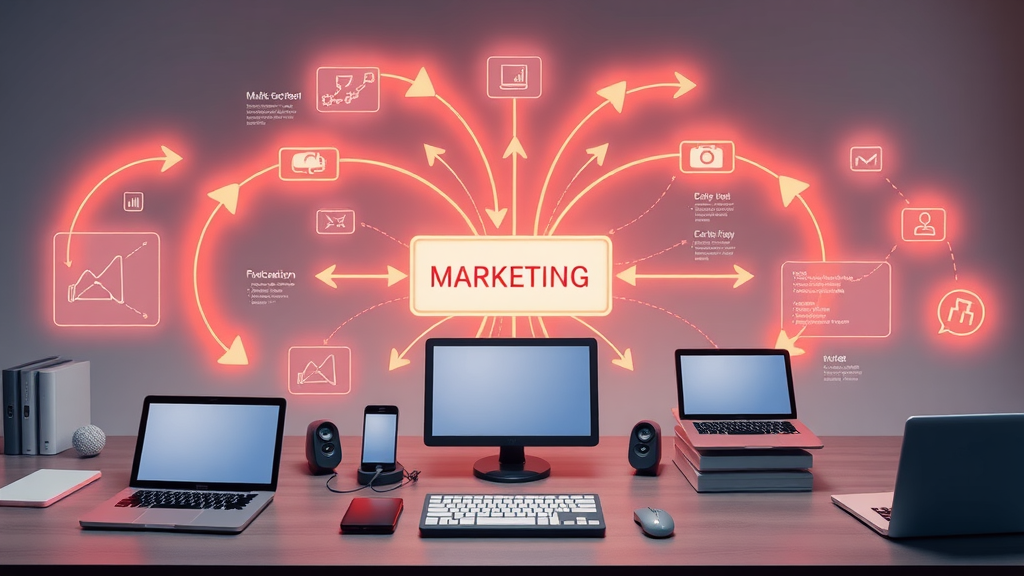Did you know over 80% of consumers now research businesses online before making a purchase? Discover the compelling online marketing benefits that can transform your small business success.

Unlocking Online Marketing Benefits for Small Businesses: Your Roadmap to Competitive Advantage
- In this article, you’ll learn how online marketing benefits drive business growth, branding, customer relationships, and long-term success for small businesses.
| Feature | Traditional Marketing | Online Marketing |
|---|---|---|
| Reach | Local/Regional | Global & Targeted |
| Cost | High | Budget-Friendly |
| Targeting | Broad, Less Precise | Highly Granular |
| Analytics | Delayed, Limited | Real-Time, Comprehensive |
| ROI | Hard to Measure | Clear & Optimizable |
"In today’s digital world, ignoring online marketing is like opening a business but not telling anyone." — Anonymous Marketing Expert
Why Online Marketing Benefits Matter Most for Small Business in the Digital Age
- Definition of online marketing: Leveraging digital channels such as search engines, social media, email, and websites to promote products and services.
- Impact of digital marketing on small businesses: Levels the playing field, enabling you to reach potential customers anywhere and maximize marketing ROI on a modest budget.
- How online marketing helps businesses overcome traditional barriers: Gone are the days when only big brands could afford impactful outreach! Online marketing breaks down geographic boundaries, empowers data-based targeting, and measures every dollar spent.
Today’s most successful small businesses understand that traditional marketing methods are no longer enough. By embracing digital marketing strategy—including search engine optimization, social media, and content marketing—small businesses can access powerful tools to grow. Where once advertising required huge budgets, online marketing benefits deliver affordable options, customizable campaigns, and analytics that drive real results.

The Role of Online Marketing in the Modern Small Business Landscape
- Customer reach: Online platforms allow you to reach potential customers beyond your local area, opening new markets and expanding your customer base.
- Brand awareness: Social media and search engine marketing enable you to build brand awareness by being visible where your audience spends time online.
- Industry authority: Content marketing positions you as an industry expert; publishing valuable blog posts, videos, and resources builds trust and credibility.
Leveraging digital marketing tools like social media , email marketing, and real-time analytics, small businesses can communicate directly with their audience. This not only deepens customer relationships but also ensures your brand awareness and authority grow steadily in your niche. Today, thriving in a crowded marketplace means having clearly defined marketing strategies that prioritize digital channels.
Furthermore, search engine optimization (SEO) plays a pivotal role in how customers find businesses online. Having a strong presence in search engine results pages (SERPs) positions your business as a trustworthy source, which is invaluable for building lasting connections with new and existing customers. Effective digital marketing campaigns create a cycle of increased traffic, greater engagement, and improved sales conversion.
Digital Marketing vs. Traditional Marketing: Which Truly Benefits Small Businesses?
- Cost-effectiveness: PPC ads, email campaigns, and social media posts often cost less than print ads, direct mail, or TV spots.
- Flexibility: Digital campaigns can be launched, paused, or tweaked on the fly to respond to real-time data or market shifts.
- Measurability: Online marketing benefits include detailed reporting and analytics, so you can track every important action, from clicks to revenue.
The old way— traditional marketing —relied on broad, untargeted techniques, making it tough for small businesses to see real impact or manage budgets. In contrast, digital marketing provides unparalleled control and feedback. You choose marketing channels that deliver the best ROI, experiment with A/B tests, and adapt campaigns instantly based on results.
More than just cost savings, the flexibility of digital campaigns empowers you to test new ideas, target specific audiences, and maximize every dollar. Whether you’re a solo entrepreneur or have a small team, online marketing benefits put data-driven decision-making at your fingertips. With tools like Google Analytics, social media dashboards, and email marketing reports, you can measure outcomes and refine strategies continually.
Ultimately, effective digital marketing strategies drive better business results, allowing you to engage customers more personally, compete with larger brands, and scale efforts as you grow. This agility is critical for the modern small business operating in a digital-first world.
The 47 Most Impactful Online Marketing Benefits for Small Businesses
1. Expanding Brand Awareness with Online Marketing
- Internet reach: Online marketing opens doors to a global audience, vastly increasing brand exposure for small businesses.
- Social media: Platforms like Facebook, Instagram, and LinkedIn make it easier than ever to promote your business and connect with followers.
- Local and global visibility: Targeted ads and content put you on the digital map for local customers while opening new markets worldwide.
By actively participating in social media and updating your website, you foster greater brand awareness and keep your small business top-of-mind. With millions of consumers using Google and social platforms daily to discover businesses, your marketing strategy can reach potential customers wherever they are—locally and globally. This ability to engage on digital channels is essential for small businesses looking to grow their footprint and remain competitive.

2. Unlocking Cost-Effective Strategies for Small Business Using Digital Marketing
- Budget-friendly options: Digital ads, social posts, and email marketing campaigns can be launched with even a modest budget.
- Performance tracking: Use analytics to monitor every dollar spent and gauge campaign effectiveness in real time.
- ROI maximization: Every marketing dollar is accountable, and strategies can be adjusted to optimize returns.
When compared to traditional channels like print or TV, digital marketing is exponentially more affordable. Performance can be tracked closely with tools like Google Ads dashboards, revealing which ads convert and which need to be retooled. This level of insight lets you double down on tactics working best for your small business, boosting your overall ROI.
Flexible pricing models, such as pay-per-click and social media advertising, ensure that you never overspend. Small businesses can experiment, scale, or pivot without incurring heavy upfront costs, making digital campaigns the logical choice for those wanting to stretch their marketing budgets.
3. Real-Time Analytics and Data-Driven Marketing Channels
- Google Analytics: Instantly understand what drives visitors, which pages work best, and where new leads come from.
- Customer insights: Real-time data exposes customer trends and preferences so you can optimize your digital marketing strategy.
- Optimizing campaigns: Use analytics to fine-tune ads, landing pages, and offers for maximum conversion.
Real-time analytics make it easy for small businesses to make better decisions. No longer do you have to wait weeks for campaign reports. Monitor web traffic, engagement, and conversion rates in the moment, and adapt your marketing strategies accordingly. With digital marketing, data powers every move you make, letting you fix underperforming areas right away.

4. Targeted Messaging with Content Marketing and Social Media Marketing
- Audience segmentation: Online platforms allow you to deliver custom messages based on demographics, interests, location, and more.
- Personalized communications: Email and content marketing adapt messages for each user, increasing engagement and loyalty.
- Social channels: Leverage media platforms like Instagram, Facebook, or LinkedIn to build highly effective brand conversations.
With digital channels, you can carefully define your target audience and communicate with precision. Segmentation and personalization—cornerstones of content marketing campaigns —lead to better open rates, more shares, and higher sales. Social media marketing produces instant feedback loops, showing which content resonates best.
Tactics like retargeting, email list segmentation, and influencer marketing give small businesses a distinct edge, ensuring that marketing efforts hit the right audience. Whether through blog posts, videos, or social media, crafting meaningful, relevant content is vital for growth.
5. Enhanced Engagement through Social Media and Media Marketing
- Two-way communication: Social media platforms allow for conversations, not just broadcasts.
- Customer feedback: Reviews, comments, and messages offer direct insight into what your audience loves or wants improved.
- Brand loyalty: Consistent, transparent communication keeps customers engaged and loyal to your brand.
Social media marketing transforms passive viewers into active participants. Inviting your audience into a conversation strengthens connections and builds trust. This engagement fuels brand loyalty and leads to repeat business, critical for long-term success. Plus, immediate customer feedback allows you to adjust course and satisfy customers in real-time.
Sharing interactive posts, responding to questions, and leveraging user-generated content on platforms like Facebook or Instagram humanizes your small business, forging deeper relationships and making your brand stand out in crowded feeds.
6. Building Valuable Customer Relationships via Email Marketing
- Nurture leads: Schedule welcome, follow-up, and educational messages to guide prospects along the path to purchase.
- Retain customers: Use personalized email content and exclusive offers to keep fans coming back.
- Re-engagement campaigns: Remind customers of your value and prompt action from inactive subscribers.
Email marketing is among the highest-ROI channels a small business can use. By building and nurturing an email list , you have direct access to your audience’s inbox. This direct line increases the odds of conversions, whether it’s launching a new product or announcing a flash sale. Segmenting messages based on customer behavior, purchase history, or engagement boosts relevance and effectiveness.

7. Increased Website Traffic and Leads through Search Engine Marketing
- SEO fundamentals: Optimize your website and content to rank higher in search engine results for queries that matter to your customers.
- Driving organic results: Search engine optimization reduces dependence on paid traffic, delivering highly-qualified, long-term leads.
- Paid search advertising: Google Ads and PPC campaigns generate immediate, targeted site visits from potential buyers.
Search engine marketing attracts a steady stream of highly motivated prospects. By focusing on search engines like Google, small businesses secure valuable online real estate where buyers begin their journey. Investing in both organic and paid strategies ensures that your brand appears at the top of search results, making it easier for eager customers to find and choose your business.

8. Measuring Success Easily: Why Online Marketing Benefits Include Detailed Reporting
- Conversion tracking: Monitor exactly which tactics drive sales, form fills, or other high-value actions.
- ROI reports: Access data that shows your true marketing return on investment down to the campaign or ad level.
- A/B testing: Test subject lines, images, offers, or landing pages to continually improve performance.
Detailed analytics are at the core of the online marketing advantage. Tools like Google Analytics or integrated dashboards show what’s working and what isn’t in real time. Small businesses can experiment with messaging, creative, or targeting, making small adjustments for maximum impact without heavy expense.
Transparent reporting ensures that every marketing campaign is accountable. You’ll know exactly which channels, creatives, and calls-to-action move the needle for your small businesses—letting you invest where it counts.
9. Flexible Marketing Channels for Any Small Business Need
- Multichannel campaigns: Blend email, social media, search, and content marketing to reach your audience on their preferred platforms.
- Integration: Connect your messaging seamlessly across channels for a consistent brand experience.
- Adaptability: Launch, pause, or scale campaigns as your business needs change or new opportunities arise.
Flexibility is a core online marketing benefit. Unlike fixed campaigns in traditional media, digital marketing channels allow for swift pivots and real-time responses. Integrating social media, email, and content outreach multiplies touchpoints and supports more cohesive, effective marketing strategies.

10. Scaling Growth Opportunities through Digital Marketing Strategy
- Agility: Add or remove channels as needed; react instantly to market changes.
- Scaling up/down: Expand winning campaigns quickly or scale back to conserve resources as needed.
- Entering new markets: Use targeted ads and content to test traction in new locations with little upfront risk.
A robust digital marketing strategy gives small businesses a blueprint for sustainable, scalable growth. Whether you want to aggressively expand or cautiously test new ideas, online marketing provides the flexibility and feedback you need. Enter new geographic markets, launch innovative product lines, or tap into new audience segments—all with minimal risk and capital investment.
With effective digital marketing strategies in place, even startups and solopreneurs can compete against much larger entities, making bold, data-driven decisions that maximize every opportunity.
- Mobile marketing: Reach an always-connected audience via SMS, push notifications, and mobile-friendly ads and sites.
- Marketing automation: Save time and streamline repetitive tasks with automated emails, lead nurturing, and social posting.
- Influencer partnerships: Collaborate with trusted social media personalities to amplify your brand to niche audiences.
- Affordability: Troves of free and low-cost marketing tools mean even microbusinesses can benefit.
- Stronger branding: Consistent digital presence elevates perception and builds professionalism.
- Reputation management: Monitor and respond to online reviews to maintain a positive image.
- Remarketing: Advertise to users who already interacted with your site, dramatically increasing conversions.
- Personalized offers: Deliver special deals via email or SMS based on individual preferences.
- Customer experience (CX): Use feedback and analytics to improve every interaction, online and offline.
- Video marketing: Leverage YouTube, TikTok, and Instagram Reels to boost brand awareness and engagement.
- Blogging: Share expertise, build SEO authority, and draw in organic traffic with valuable content.
- Webinars and virtual events: Educate, engage, and convert audiences in real time without geographic barriers.
- Conversion optimization: Test layouts, colors, and copy to maximize sales and sign-ups.
- Immediate feedback: Digital platforms reveal what’s working and what isn’t almost instantly.
- Trend awareness: Spot shifting customer preferences early and pivot strategy for faster results.
- Easy collaboration: Use cloud-based tools to coordinate campaigns between team members, no matter their location.
- Community building: Create online groups, forums, or customer clubs to drive deep loyalty.
- 24/7 promotion: Your digital storefront never closes; attract sales around the clock.
- Online PR: Distribute press releases and build buzz through digital news outlets.
- Customer journey tracking: Map every step from awareness to purchase for smarter marketing.
- Lead generation forms: Capture qualified prospects using strategically placed website forms and pop-ups.
- Creative testing: Run split tests on ads, emails, and landing pages for continuous improvement.
- Crisis response: Rapidly address negative publicity or business interruptions through digital channels.
- Geo-targeting: Tailor messages to users by their specific location for local events and promotions.
- Event promotion: Boost attendance for webinars, workshops, and pop-ups using targeted digital campaigns.
- Upselling and cross-selling: Recommend complementary services or products post-purchase with trigger-based emails.
- Secure transactions: Robust platforms offer SSL and fraud controls for safe online sales.
- Marketplace access: Tap into Etsy, Amazon, or eBay to quickly expand your reach.
- Social proof: Showcase testimonials, ratings, and case studies to build trust.
- Global expansion: Test products and markets in new countries with minimal upfront investment.
- Accessibility: Accessible websites and campaigns allow you to reach more customers, including those with disabilities.
- Resource efficiency: Use automation and AI-driven tools to stretch budgets further.
- Innovative ad formats: Experiment with new media, such as VR or AR, for enhanced engagement.
- Environmental impact: Reduce paper use and waste by shifting from print to digital campaigns.
- Time savings: Schedule posts, emails, and campaigns so you never miss an opportunity.
- Multilingual reach: Create campaigns in different languages to serve diverse communities.
- Self-serve capability: Platforms like Facebook and Google Ads let you launch campaigns instantly without an agency.
- High conversion rates: Online ads tailored to specific audiences deliver higher ROI.
- Sophisticated segmentation: Slice your audience by age, behavior, interests, and more for tailored offers.
- Rapid scaling: Boost successful ad budgets and campaigns quickly to capitalize on momentum.
- Content repurposing: Turn a blog post into a video, infographic, or email for extra mileage.
- Automated reminders: Nudge customers about appointments, restocks, or abandoned carts for improved sales.
- Easy performance comparison: Stack current results against prior campaigns for data-driven improvements.
- Third-party integrations: Connect your CRM, website, and social platforms for seamless data flow.
- Grant and funding visibility: Promote your business to organizations offering small business grants.
- Competitive intelligence: Monitor rivals’ digital presence to inform your own strategy and stay ahead.
How to Leverage Online Marketing Benefits Through Effective Marketing Strategies
Crafting Powerful Digital Marketing Strategies for Small Businesses
- Aligning your business’s goals with actionable digital tactics creates a direct path to measurable results.
- Develop content marketing plans to provide value and build trust within your niche.
- Establish authentic engagement through tailored social media marketing approaches, focusing on platforms where your target audience is most active.
Crafting an effective digital marketing strategy starts with clear objectives and measurable milestones. Whether your goal is generating leads, boosting brand awareness, or driving online sales, your plan must align with tactics proven to move the needle for small businesses—think SEO, targeted ads, content marketing, and email automation. Integrating these elements creates synergy, maximizing your exposure and conversion potential.

Choosing the Right Marketing Channels to Maximize Return
- Adopt omni-channel tactics, ensuring consistent messaging and experience no matter how your customers find you.
- Balance organic methods like SEO and earned media with cost-effective paid strategies, optimizing your marketing channel mix based on performance.
- Prioritize high-impact platforms, focusing on those with strongest audience overlap and engagement potential for your market.
Selecting optimal marketing channels means understanding where your customers spend their time. For some small businesses, search engine optimization may drive most leads; for others, paid social media campaigns or influencer collaborations lead the way. By trialing and comparing, you can direct your budget to platforms delivering the highest ROI.
The ability to adjust strategies quickly is one of the core online marketing benefits for small businesses. Testing, analyzing, and doubling down on what works minimizes waste and maximizes outcomes, whether you’re using Google Ads, Facebook, LinkedIn, or emerging social platforms.
Optimizing Existing Campaigns for Maximum Online Marketing Benefits
- Use A/B testing to constantly refine ads, emails, and landing pages for ongoing improvement.
- Leverage analytics-driven insights to update content, offers, and targeting settings based on the latest performance data.
- Solicit and integrate customer feedback throughout your marketing campaigns to ensure relevance and value.
The path to consistent growth is paved with ongoing optimization. Set aside time monthly for a marketing audit: review your analytics, test new headlines or visuals, and segment customer lists for targeted content. Even small improvements—like changing an email subject line or refining ad targeting—can yield measurable boosts in leads or revenue.
Engaging directly with customers via surveys or feedback tools helps refine every touchpoint, ultimately delivering a tailored, best-in-class experience that keeps customers coming back.
Online Marketing Benefits in Action: Case Studies from Leading Small Businesses
- Bella’s Boutique: After launching a multichannel marketing strategy—combining Instagram campaigns, email offers, and local SEO—sales doubled in six months. The owner cites analytics-driven decision making and customer engagement as key drivers of growth.
- Green Thumb Landscaping: Utilizing Google Ads and Facebook videos, this service-focused business generated 60% more leads in one quarter. Real-time analytics enabled weekly optimizations, minimizing ad spend while maximizing customer reach.
- TechHelp Co.: By offering webinar series and downloadable guides through content marketing, TechHelp nurtured leads into paying customers, growing their email list by 155% and cementing their reputation as a local industry leader.

Essential Tools & Resources to Maximize Online Marketing Benefits for Small Businesses
- Email Marketing Platforms: Tools like Mailchimp or Constant Contact automate campaigns and segment lists for targeted communications.
- SEO Software: Optimize content and track rankings using SEMrush, Moz, or Ahrefs.
- Analytics Suites: Google Analytics and Hotjar provide real-time data on user behavior and site performance.
- Social Media Scheduling Tools: Buffer and Hootsuite help you plan, schedule, and analyze campaigns across platforms.
- Graphic Design Apps: Canva and Adobe Express allow you to craft professional visuals even without design experience.
- CRM Systems: HubSpot and Zoho manage leads, automate follow-ups, and track the full customer journey.
Expert Tips to Achieve Consistent Online Marketing Benefits on a Budget
- Focus on essentials: Maximize impact with compelling website copy, active social media accounts, and regular email outreach.
- Repurpose content: Get extra mileage by turning a blog post into videos, social snippets, and email tips.
- Leverage free tools: Use Google My Business, Canva, Mailchimp (free tier), and social media platforms to build a strong foundation for little or no cost.
- Monitor and adjust: Regular analytics reviews ensure you’re putting resources where they matter most.
"With the right marketing strategy, any small business can turn online marketing benefits into long-term growth." — Digital Marketing Specialist
People Also Ask: Answering Your Top Questions About Online Marketing Benefits
What are the benefits of marketing online?
- Online marketing benefits include expanding your audience reach far beyond local boundaries, maximizing cost efficiency, accessing real-time analytics, improving targeting accuracy, and boosting your brand presence with both new and existing customers.
What are 5 advantages of digital marketing?
- Greater audience reach, precise targeting capabilities, affordable advertising, measurable and transparent results, and more significant opportunities for customer engagement set digital marketing apart from traditional techniques.
What are the 4 benefits of e-marketing?
- Global market access, personalized customer communications, lower overall costs, and the speed at which campaigns can launch and scale are four compelling e-marketing benefits for any small business.

Which are the benefits of advertising online?
- Online advertising provides scalability for campaigns, instant feedback and performance tracking, highly precise audience targeting, easy campaign adjustments, and often a higher ROI compared to offline options.
Frequently Asked Questions About Online Marketing Benefits for Small Businesses
- What are online marketing benefits for startups? Startups gain exposure, establish credibility, and immediately compete with larger players by leveraging low-cost digital advertising and content marketing.
- How fast can small businesses see results from digital marketing? Results can appear as soon as a few days for paid ads, while strategies like SEO and content marketing often build traction within weeks or months.
- Does online marketing help with customer retention? Absolutely—personalized emails, targeted social campaigns, and retargeting keep current customers engaged and coming back.
- What online marketing channel offers the best ROI? Email marketing and organic SEO are typically among the highest-ROI channels, but your results depend on your industry and execution.
- Can online marketing benefits be sustained long-term? Yes! Consistent strategy, optimization, and customer engagement ensure small businesses enjoy ongoing growth from online marketing benefits.
Key Takeaways: Maximizing Online Marketing Benefits for Small Businesses
- Online marketing offers unmatched benefits for small business growth.
- A multi-channel approach yields the most consistent outcomes.
- Analytics and constant optimization amplify marketing ROI.
- Even limited budgets can access significant online marketing benefits.

Start Unlocking Online Marketing Benefits for Your Small Business Today
- Act now—every day without an online marketing strategy is a missed opportunity for growth.
- Explore the essential resources and tools highlighted here and start building your next campaign.
- Schedule a consultation with a digital marketing professional or launch your own campaign to see online marketing benefits for your small business immediately.
Ready to take action? Transform your business’s future by embracing online marketing benefits today!
To further enhance your understanding of online marketing benefits for small businesses, consider exploring the following resources:
-
“Top 10 Benefits of Digital Marketing Over Traditional Marketing” : This article outlines key advantages such as better brand awareness, wider customer reach, and increased customer engagement, providing a comprehensive overview of how digital marketing can transform your business. ( emeritus.org )
-
“What is Online Marketing? Definition, Types, and Benefits” : This resource delves into the fundamentals of online marketing, discussing various strategies and their benefits, including reduced expenses, improved customer service, and competitive advantage, offering a solid foundation for implementing effective online marketing tactics. ( business.adobe.com )
By exploring these articles, you’ll gain valuable insights into how online marketing can drive growth, enhance customer relationships, and provide a competitive edge for your small business.
 Add Row
Add Row  Add
Add 




Write A Comment